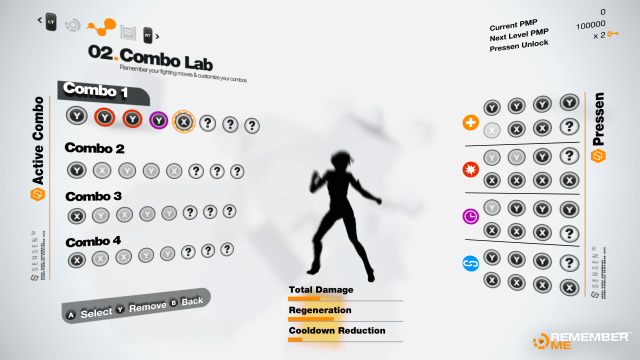Remember Me takes a lot of mechanics that you’ll have played with before, and does something interesting with them. Now, that sounds like I’m damning the game with faint praise, but I’m not, because Remember Me feels so individual thanks to some truly fascinating ideas that pervade the combat whilst adding mechanics that deviate massively from the genre you’d assume it is a part of. In short: be excited.
But I don’t want to be accused of over-hyping something, and it’s important to note that from the first 5 episodes of the game it’s very clear that Remember Me won’t be for everyone. If you watch videos of the combat in action, you’d be forgiven for thinking that it’s a relatively straightforward take on the third-person hack and slash genre, but it’s not. You do attack using melee, and yes, it’s a combo-based affair, but “straightforward” would be the absolute worst word to describe the combat. Sure, you’ll act out combos using the X and Y buttons – on an Xbox 360 controller, anyway – and of course there’s a button to dodge, but it’s what the combos do that makes the combat so interesting, so unique.
As the player, it is your job to build the combos, to add the pieces together to create a devastating attack-flow that not only damages the enemy, but also recharges your health and your special move cooldown meter. The system appears so complex at first glance that concentration is required from the player, which is a nice change from the normalcy that faces experienced gamers these days.

I’m going to try and give an example of the combos you can create, as well as what they do, and how they actually work. The X button is the “damage” part of the combo, but also has an alternate use that can quicken the cooldown on your special move. The Y button is the “health regeneration” part of the combo, and if you use it correctly and perform an uninterrupted combo, you can regain health lost in battle. The Y button also has a secondary use, allowing you to chain combos further, with it inheriting and multiplying the effect of attacks that precede it in the chain.
So let’s call the damage move “X1”, the cooldown move “X2”, and the recharge move “Y”, and analyse the following 5-piece combo:
- X1 – You start with a heavy damage attack
- Y – Throw in a health regeneration attack
- X2 – Now you land an attack which drops your 60 second cooldown timer by 10 seconds
- Y – Another piece of health can be gained back
- X1 – Finishing up with another damage-based attack
Now, the further down the combo you place a move, the stronger it will be. So if you finish on a health regeneration move, you’ll gain more health, and so on. These combos aren’t based on button mashing, you have to design them in the pressen menu (pressens is the name for the combos/moves) and lay them out onto a button-map styled area, then you can use them in combat. The dodge button allows you to jump over an enemy’s head when you see the tell-tale sign that they are about to attack, whereby you can finish the combo off, uninterrupted. It sounds complicated, and to a degree it bloody well is, but it’s also interesting and incredibly satisfying.
The special moves (S-pressens) aren’t so tricky to understand. Once unlocked, holding L1 will open a radial menu that allows you to pick the S-pressen out, and unleash something akin to a fury onto your foes. Disregarding the combo system entirely, Nilin will let you hammer X or Y here, and you can still dodge, releasing a flurry of manic punches and kicks to whoever is in your way. Once used, a cooldown timer appears before you can use the S-pressen again, which is why it’s important to have a varied combo somewhere in your arsenal. One boss is far easier to dispatch if you land 3 successive combos that include an S-pressen cooldown move, because you can get more damage in every three combos, thanks to the S-pressen.
While you are exploring this superb combat idea in the universe of Neo-Paris, which from the first 5 missions switches from grimy, dingy underground lairs full of monstrosities, to the hoity-toity upper echelons of high society, you’ll only be able to traverse the walls, windows and streets in a strictly linear world. Make no bones about it, because DONTNOD make no apologies for the manner in which the game will mainline its story, with exploration limited to collectibles that litter the surrounding areas, never allowing the player to stray too far from the beaten path.
Such a clever combat system would be enough, but then there’re the Memory Remix modes, too, which tie in to the story so well, adding yet another layer to Remember Me and giving the player something else they’ve not experienced before.
Without spoiling anything, Nilin is one of the best at extracting memories from people – so much so that she can alter their memories to her will. An early scenes has one of the colourful characters in the game attempt to murder her for the bounty on her head. Her husband is one of the many who have nearly lost their mind thanks to the memory-addiction that plagues Neo-Paris (leaving those who go too far as complete husks, borderline zombies) and to rescue him, she needs expensive treatment. Enter Nilin and her high bounty. Just at the point where all looks lost for our heroin, she reaches toward the back of her attacker’s head and enters her memory, to remix it and change her fate.

The memory remixes are entirely contained within the location they take place in; in this example, it’s a sterile hospital room. It’s hinted at that, if the would-be killer’s husband died on the table, there’d be no reason for her to need money, thus no need for her to kill Nilin for the bounty. To remix the memory, you can interact with objects in the environment that may change things as they play out. Rotating the left stick forward or backwards will fast forward or rewind the memory, allowing you trial and error, but there’s no fail state, and if you get it all wrong you just need to rewind the memory and start again. Having no fail state means no loading for these sections, which is a welcome thing. The closest thing I’ve ever played to the memory remix sections would be the Nintendo 3DS game, Ghost Trick, which (depending on your perspective) is a brilliant thing.
Yet for all of these interesting elements, for all the fascinating story, Remember Me has me worried. This is a game that takes risks with its mechanics, a game that introduces ideas that you wouldn’t necessarily ever find mashed together in one game. Based on the first 5 episodes, it absolutely works – but I was left thinking of Enslaved: Odyssey to the West; another brilliant game that didn’t sell enough copies. I’m not suggesting that Remember Me will befall a similar fate at all, only pointing out that often, good games don’t do well enough. Here’s hoping Remember Me does enough, because in an industry where developers are happily saying they like to “play it safe” with no fear of comeback and nobody calling them on it, DONTNOD aren’t playing it safe at all, they are creating something wholly unique – and that’s worth championing.





